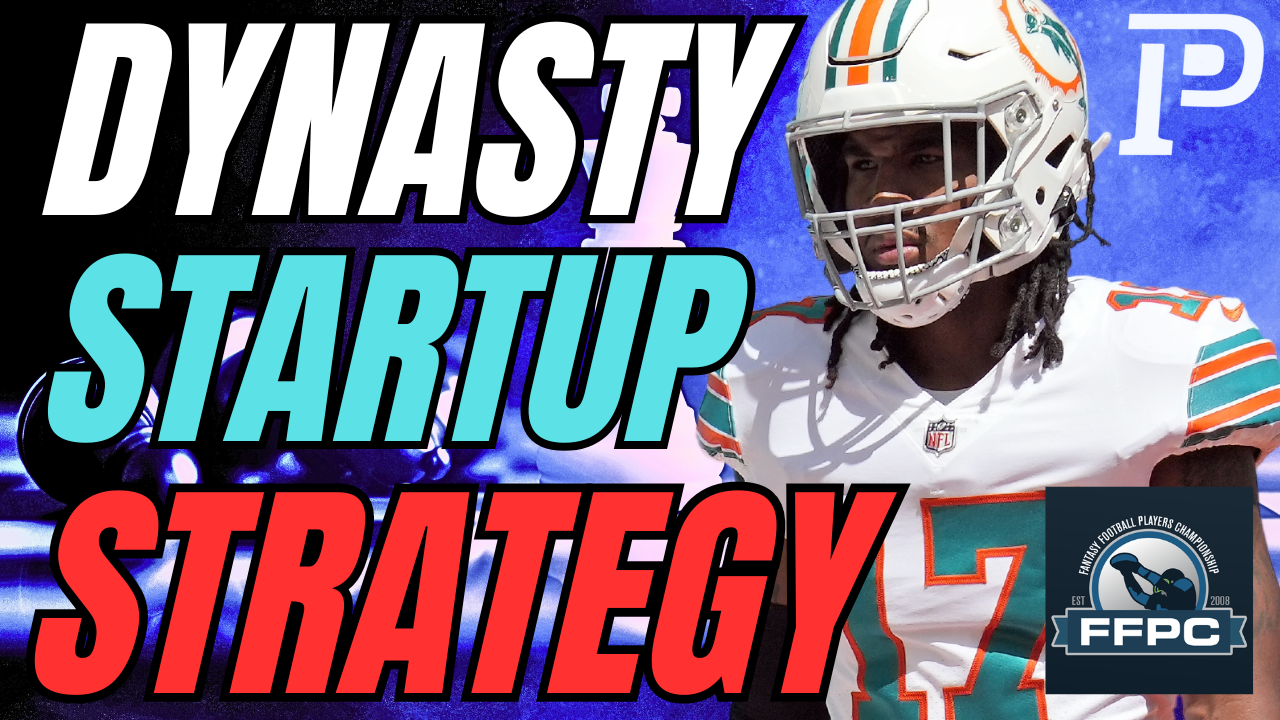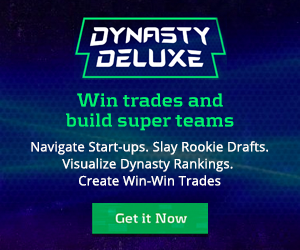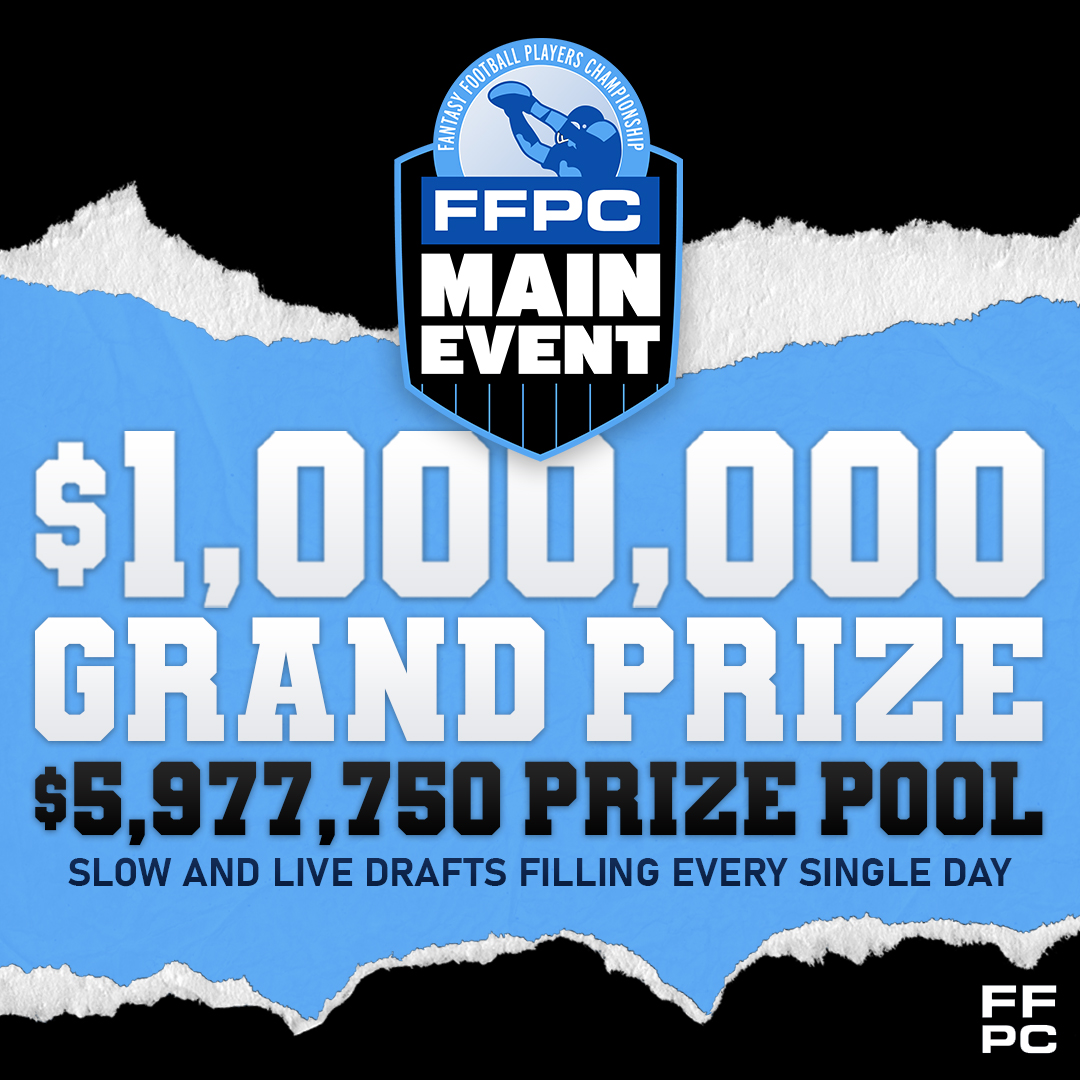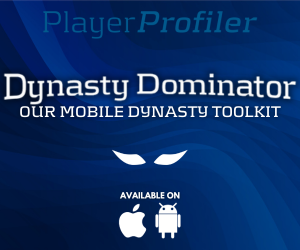There’s no better time to add to your dynasty portfolio than right now, with training camps just getting underway. The news cycle will spur player movement in every fantasy format. However, some of the biggest bargains will come in dynasty leagues if you play the market correctly. And if you are interested in implementing the Dynasty Startup Strategy in this article to draft a dynasty startup, there’s no better place to draft than the FFPC.
They have over 2,000 active dynasty leagues (yes, 2000, that is not a typo) and not a single league has ever folded. They are adding dozens more each year as the appetite for dynasty continues to grow. Therefore, it’s the perfect place to make your dynasty home base. Not only that, but they have several formats including basic 1QB leagues, SuperFlex, TriFlex, Best Ball, and now this year they’ve added Empire Leagues as well in all those formats.
I’ve already done multiple startups this year in the FFPC. I want to give you some of my biggest takeaways as I’ve constructed my own teams and watched all the other managers in each of my leagues construct their teams as well. For the most part, these rules of thumb translate well to any startup. However, they are especially helpful in the FFPC environment of TE-Premium scoring and multiple flexes.
FFPC has never-too-early best ball tournaments ➔ https://myffpc.com/cms/public/play/never-too-early-superflex-best-ball-tournament-2 and use Code UNDERWORLD for $25 off your first team.
Use the Fantastic Trade Analyzer in the Dynasty Deluxe Package at Player Profiler
I don’t mean to come off as a shill for the house. However, if you’re at all serious about playing dynasty football, you need the Dynasty Deluxe package. The rankings, the ADP tracker, the player profiles, the rookie guide…these are all fantastic tools that I use on a daily basis even though I’ve been playing dynasty for 10 years now. But, the very best tool of them all is the Trade Analyzer.
It’s an absolute necessity to building the confidence to make good trades in startup drafts where these trades can be combinations of startup picks, future rookie picks, and even already-drafted players. You don’t have to win every trade according to the Trade Analyzer. However, if you make a habit of losing trades because you don’t use it, that’s going to make dynasty an uphill climb for you. Best of all, the values in the Trade Analyzer are regularly audited and changed by the excellent dynasty team here at PlayerProfiler based on our own experiences making trades.
Trade FOR Future Draft Picks Early in the Draft Even if You Plan to Play a Win-Now Strategy
This might seem like crazy talk. So, let me explain. Future draft picks are always, always, always the most liquid assets your team can own. You can use them later in the startup draft to buy a pick or picks. A Dynasty gamer can use them to facilitate moving around the draft board to swoop in and steal a player that fits your build at a bargain price. You can use them after the draft to help your team navigate an unexpected injury. A Dynasty gamer can use them to trade for a key player down the stretch run to put your team over the top. The more value you can store in future picks early in the draft, the better. This will always be a tenet of good Dynasty Startup Strategy
Consider also, in the FFPC environment, you must pay a deposit against next year’s entry fee anytime you trade away your first-round pick. But if you acquire someone else’s first-rounder, you can trade either your first or the previously-acquired first without having to pay that deposit. It’s only when you trade that final first-rounder in your bag of picks that you’ll have to pay the deposit. That brings up another advantage of owning multiple first-rounders. You have optionality over which pick you want to trade.
Trading Away a Future 1st
Often there will be one manager who eagerly trades away his future first and then fumbles the startup draft, building an only marginally-competitive team. In the FFPC world where non-playoff teams battle it out for the 1.01 in the toilet bowl, owning the pick from such a team can put you in the driver’s seat for that coveted 1.01. If you are the lucky manager who acquires that pick, you’ll probably begin to realize it early enough in the startup draft that you can pivot to trading your own future first instead of the one you bought.
Don’t Overpay for Non-Elite WRs
Of course, if you’re going to trade down in a startup in order to pick up those highly-liquid future draft picks, you need a plan to still field a highly competitive team. One highly effective Dynasty Startup Strategy is to sacrifice “sex appeal” in favor of similar productivity from less-sexy assets. For example, you could take DK Metcalf with a fifth-round Tri-Flex startup pick, or you could get similar production from Chris Godwin in the ninth round. You should be able to get a future first instead of making the pick in the fifth round. Both of them are likely to average 11-15 points a game, and both could be free agents after this season. There’s a lot less difference between Metcalf and Godwin than most dynasty managers are willing to admit.
One of the biggest hacks in dynasty is realizing there are numerous WRs who are stuck scoring between 11-15 PPG every year, but the cost to acquire them varies wildly. Don’t pay up for hope and hype. Only pay up for projectable targets. Jaylen Waddle has the physical talents that make any good dynasty manager drool. This is why he’s going between picks 35-40 in Superflex/TriFlex startups which is in the WR12-14 range.
Tyreek Hill vs Jaylen Waddle
But since Tyreek Hill arrived in Miami, Waddle hasn’t topped 117 targets in a season. Until or unless Tyreek Hill retires or gets hurt, Waddle isn’t going to sniff the volume it will take to pay off that price in a startup. How long can you afford to wait for Waddle to pay off? Meanwhile, you’re getting just 14-15 PPG while you wait. Not bad, but not the return you need on the cost of investing when you can get such similar production rounds later.
If a WR doesn’t have a likely path to 135+ targets, the odds are excellent they’ll leave you at least slightly disappointed, barring a fluky season of TD-scoring prowess. Let others buy the hype of Metcalf, Waddle, Zay Flowers, and Tee Higgins (just to name a few) and sell those picks for future draft capital that can be used anytime you need.
Elite TE is an Edge Worth Paying For
Due to the combination of TE-Premium scoring of FFPC (1.5PPR) and having two, or even three, flex spots available for TEs, there’s good reason to spend your precious start-up draft capital for a TE who can reliably project as a top-2 target on his NFL offense. Those are the options that will give you a big advantage at a “onesie” position. If you end up with more than one of them, you can always use them as a flex.
For this year, those TEs are Sam LaPorta, Tre McBride, Travis Kelce, Dalton Kincaid, Evan Engram, Mark Andrews, Kyle Pitts, and Jake Ferguson. Potentially joining that list (for at least this year) are Pat Freiermuth and David Njoku. Brock Bowers has the profile to someday join this group, but that’s a shaky bet for this year. And that’s it. Once these players are gone, you are better off waiting until the 17th round or so because otherwise you’re just throwing away draft capital that is much better spent on other positions.
Be Careful in the Middle Rounds
Tyler Conklin, Noah Fant, and Hunter Henry offer virtually identical ceilings and floors to brand name options like Dallas Goedert, Dalton Schultz, and Cole Kmet who are likely to come in third or fourth at best on the target totem pole. Buying those brand names will rob you of chances to draft players who have access to real upside to be worth far more either in-season or next year, such as Zack Moss, Chase Brown, Jermaine Burton, Troy Franklin, or whatever your flavor of choice is in those middle rounds.
As always, even for the elite options, price is at least partly a function of sex appeal. LaPorta, McBride, and Kincaid are the designer options and disappear by the end of the 3rd in SuperFlex/Triflex, whereas you can still shop in the bargain bin for less sexy options like Engram and Ferguson who go in the seventh and eighth round, respectively. Dropping back 4-5 rounds and still getting elite scoring is a great way to harvest surplus value from your startup.
Be Careful When Paying up for QB in SuperFlex
Drafting proven elite options like Josh Allen, Patrick Mahomes, Jalen Hurts, and Lamar Jackson is always a good move. You probably won’t be sorry taking C.J. Stroud either even though we’ve only seen one season from him. Past that point, though, you can pick up a lot of draft capital by avoiding the name-brand options such as Caleb Williams and Joe Burrow (both going at the end of Round 1) and dropping down to more generic options like Trevor Lawrence or Brock Purdy (currently residing in the late second or early third).
Sure, Caleb might be the next Patrick Mahomes, but he could just as easily be the next Baker Mayfield. Purdy looks every bit as good as Joe Burrow was early in his career and doesn’t come with a concerning sack rate and history of injuries like Burrow. Once again, being willing to move back is going to free up draft capital that you can spend in better ways or add future picks to your collection. Both are great examples of Dynasty Startup Strategy to implement in a startup.
Another Secret
Another seldom-discussed Dynasty Startup Strategy is that you really don’t have to pay up at all to field quality QBs. Your timeline at QB, even in a SuperFlex, needn’t be more than a couple of years as you’ll have plenty of opportunities to draft and trade your way into new options. Occasionally, you can even pick up QBs off the waiver wire that will turn into starters for you.
It’s certainly comforting to have one highly coveted and highly productive QB to build around, but you can pick up shares of Kirk Cousins, Matthew Stafford, Geno Smith and several other options in the seventh-12th rounds. Kirk Cousins, for example, finished as a back end QB1 from 2021 to 2023 and has moved to a team with a similar offense and similar surrounding offensive talent but is currently QB21 in TriFlex formats. That’s a great bet to make as your QB2 or QB3, and again, you’re just freeing up excess draft capital by making this move.
Zero-RB or Hero-RB are the Only RB Strategies You Need
Nothing destroys dynasty capital faster than paying up for RBs, with a handful of notable exceptions. This year, the RBs in the top-10 I’ll pay the current price for are Bijan Robinson, Breece Hall, Jahmyr Gibbs, Devon Achane, and Jonathon Brooks. That’s it. After that, I mostly won’t touch any RBs until we’re outside of the top-24. Why? I’ll give you two words: Talent and Age. These are the only five RBs in the top-24 who are young enough and talented enough to pay off the cost of acquisition. RB is a position where opportunity is king, injuries are frequent, and the cost is low for NFL teams to draft or sign major competition for touches the following year. It’s just not worth it to spend up unless you can be nearly certain you’re getting 2+ years of RB1 performance (barring injury, of course).
I’d much rather draft Zamir White and MarShawn Lloyd both in the 10th round than Josh Jacobs in the early fifth. In a recently completed startup, I ended up with the following RB room: Bijan Robinson, Blake Corum, Jaylen Wright, MarShawn Lloyd, Devin Singletary, Audric Estime, and Chuba Hubbard plus two future 1sts and three future 2nds available to shore up the room if need be. Other than Bijan (2.04), I spent three 10th round startup picks, a 13th, a 14th, and a 16th to pull that room together. Additionally, I have the backup options who could easily become primary options, potentially for multiple years, on four of the premier offenses for RB-scoring (Rams, Dolphins, Packers, and Broncos). This is the definition of being anti-fragile in the fragile RB world, and it a Dynasty Startup Strategy that I strongly endorse.
Conclusion
Dynasty valuations are more volatile than ever as owners react to the ever-shifting landscape of the NFL. Remember, we know far less than we think we do as we head into each new NFL season, and we want to position our rosters to benefit from that chaos. It’s far better to think in terms of finding cheaper arbitrage versions of desirable dynasty assets and visualizing what player values might look like at this time next year in the dynasty game. Along with that, remember that liquidity in the form of future picks can be deployed anytime you need it. There’s no need to burn it all up in your startup. All that does is make your team more fragile and less agile. If you remember the tenets of Dynasty Startup Strategy outlined above, you can best position your team for future success.
For more from PlayerProfiler, check out this article – Fantasy Sleepers – Targets in Dynasty Fantasy Football for 2024 (playerprofiler.com)








